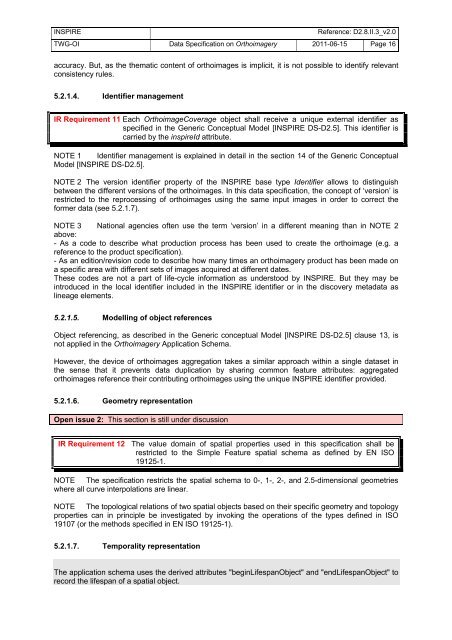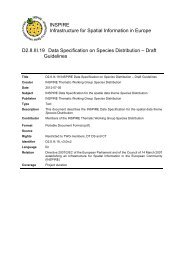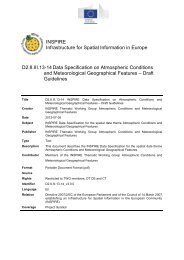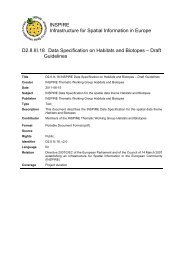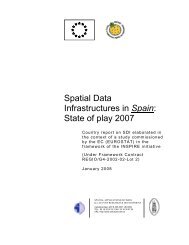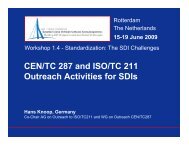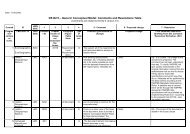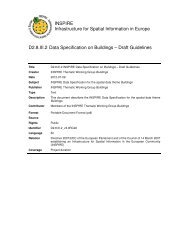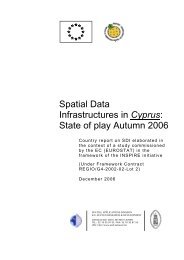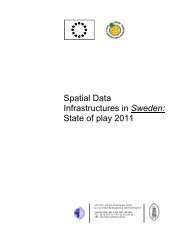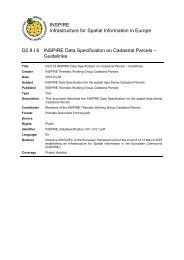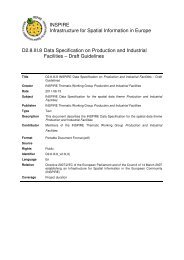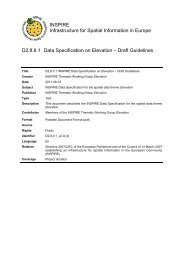Data Specification on Orthoimagery – Draft ... - INSPIRE - Europa
Data Specification on Orthoimagery – Draft ... - INSPIRE - Europa
Data Specification on Orthoimagery – Draft ... - INSPIRE - Europa
Create successful ePaper yourself
Turn your PDF publications into a flip-book with our unique Google optimized e-Paper software.
<strong>INSPIRE</strong> Reference: D2.8.II.3_v2.0<br />
TWG-OI <str<strong>on</strong>g>Data</str<strong>on</strong>g> <str<strong>on</strong>g>Specificati<strong>on</strong></str<strong>on</strong>g> <strong>on</strong> <strong>Orthoimagery</strong> 2011-06-15 Page 16<br />
accuracy. But, as the thematic c<strong>on</strong>tent of orthoimages is implicit, it is not possible to identify relevant<br />
c<strong>on</strong>sistency rules.<br />
5.2.1.4. Identifier management<br />
IR Requirement 11 Each OrthoimageCoverage object shall receive a unique external identifier as<br />
specified in the Generic C<strong>on</strong>ceptual Model [<strong>INSPIRE</strong> DS-D2.5]. This identifier is<br />
carried by the inspireId attribute.<br />
NOTE 1 Identifier management is explained in detail in the secti<strong>on</strong> 14 of the Generic C<strong>on</strong>ceptual<br />
Model [<strong>INSPIRE</strong> DS-D2.5].<br />
NOTE 2 The versi<strong>on</strong> identifier property of the <strong>INSPIRE</strong> base type Identifier allows to distinguish<br />
between the different versi<strong>on</strong>s of the orthoimages. In this data specificati<strong>on</strong>, the c<strong>on</strong>cept of ‘versi<strong>on</strong>’ is<br />
restricted to the reprocessing of orthoimages using the same input images in order to correct the<br />
former data (see 5.2.1.7).<br />
NOTE 3 Nati<strong>on</strong>al agencies often use the term ‘versi<strong>on</strong>’ in a different meaning than in NOTE 2<br />
above:<br />
- As a code to describe what producti<strong>on</strong> process has been used to create the orthoimage (e.g. a<br />
reference to the product specificati<strong>on</strong>).<br />
- As an editi<strong>on</strong>/revisi<strong>on</strong> code to describe how many times an orthoimagery product has been made <strong>on</strong><br />
a specific area with different sets of images acquired at different dates.<br />
These codes are not a part of life-cycle informati<strong>on</strong> as understood by <strong>INSPIRE</strong>. But they may be<br />
introduced in the local identifier included in the <strong>INSPIRE</strong> identifier or in the discovery metadata as<br />
lineage elements.<br />
5.2.1.5. Modelling of object references<br />
Object referencing, as described in the Generic c<strong>on</strong>ceptual Model [<strong>INSPIRE</strong> DS-D2.5] clause 13, is<br />
not applied in the <strong>Orthoimagery</strong> Applicati<strong>on</strong> Schema.<br />
However, the device of orthoimages aggregati<strong>on</strong> takes a similar approach within a single dataset in<br />
the sense that it prevents data duplicati<strong>on</strong> by sharing comm<strong>on</strong> feature attributes: aggregated<br />
orthoimages reference their c<strong>on</strong>tributing orthoimages using the unique <strong>INSPIRE</strong> identifier provided.<br />
5.2.1.6. Geometry representati<strong>on</strong><br />
Open issue 2: This secti<strong>on</strong> is still under discussi<strong>on</strong><br />
IR Requirement 12 The value domain of spatial properties used in this specificati<strong>on</strong> shall be<br />
restricted to the Simple Feature spatial schema as defined by EN ISO<br />
19125-1.<br />
NOTE The specificati<strong>on</strong> restricts the spatial schema to 0-, 1-, 2-, and 2.5-dimensi<strong>on</strong>al geometries<br />
where all curve interpolati<strong>on</strong>s are linear.<br />
NOTE The topological relati<strong>on</strong>s of two spatial objects based <strong>on</strong> their specific geometry and topology<br />
properties can in principle be investigated by invoking the operati<strong>on</strong>s of the types defined in ISO<br />
19107 (or the methods specified in EN ISO 19125-1).<br />
5.2.1.7. Temporality representati<strong>on</strong><br />
The applicati<strong>on</strong> schema uses the derived attributes "beginLifespanObject" and "endLifespanObject" to<br />
record the lifespan of a spatial object.


